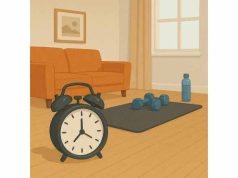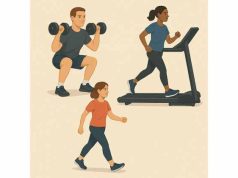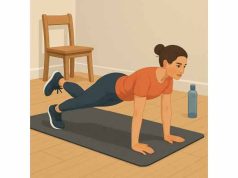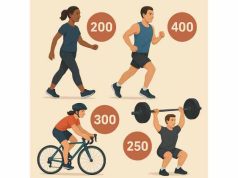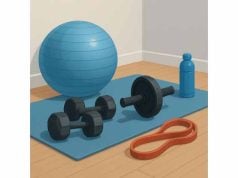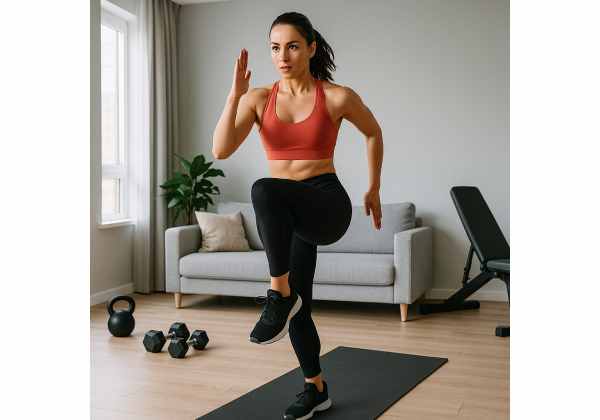
High-intensity interval training (HIIT) compresses meaningful cardio into brief sessions that fit real schedules. Done well, 20 minutes is enough to improve fitness, raise weekly energy burn, and support weight loss—without leaving you drained for the rest of the day. This guide explains how HIIT promotes fat loss, how to structure a 20-minute session, and how to adapt plans for home or gym. You’ll also find weekly templates, safety adjustments, and clear expectations for results. If you’re building a broader routine, see our balanced overview of exercise choices for weight loss to combine strength, cardio, and daily movement.
Table of Contents
- Does 20-minute HIIT work?
- How to structure 20-minute HIIT
- Home HIIT: no equipment
- Gym HIIT templates
- Weekly plan and recovery
- Who should modify HIIT
- Results and troubleshooting
- Frequently Asked Questions
Does 20-minute HIIT work?
Short answer: yes—when intensity and consistency are right. HIIT alternates hard efforts with recovery to accumulate meaningful time near your individual “high” zone without holding it continuously. The format is time-efficient, scales to fitness level, and pairs well with strength training.
Why it helps with weight loss
- Time efficiency: Brief bouts at higher effort use more energy per minute than gentle cardio, helping busy people reach a weekly activity dose that supports fat loss.
- Cardiometabolic benefits: HIIT improves aerobic capacity (VO₂max) and insulin sensitivity. Better fitness makes all movement easier, which often raises daily activity outside workouts.
- Behavioral fit: Twenty minutes is psychologically easier to schedule—and to repeat—than long sessions. Habit beats heroics.
What HIIT is—and isn’t
- HIIT is hard work in short sets (typically 15 seconds to 2 minutes), followed by recovery (equal or longer). A session includes a warm-up, 10–15 minutes of intervals, and a cool-down.
- HIIT isn’t all-out sprinting every set. “High intensity” should be hard but repeatable. If the first round looks like a max sprint, technique and pacing will collapse later.
- EPOC (afterburn) is real but modest. The extra post-workout burn is smaller than many headlines suggest. Think of HIIT’s value as total weekly work and fitness gains—not as a magic calorie bonfire.
Who benefits most
- Time-pressed adults who can’t commit to long cardio blocks.
- People who enjoy variety and clear work-rest cycles.
- Intermediates who already tolerate basic exercise volume and want a stronger cardio stimulus in less time.
Common mistakes that blunt results
- Racing every rep. Intensity should be high but repeatable across the session.
- Skipping the warm-up. Muscles and tendons need progressive ramp-up to tolerate hard efforts.
- Neglecting strength work. Muscle helps preserve metabolic rate during dieting. Include two or three short strength sessions per week.
- Relying on HIIT alone for fat loss. Nutrition and non-exercise movement (steps) still drive the deficit.
If you’re brand-new to exercise or returning after a long layoff, start with easier cardio and light strength work. For a broader foundation, see our concise guide to healthy weight-loss basics before pushing intensity.
Bottom line: A well-paced 20-minute HIIT is enough to move the needle for fat loss and fitness—provided you respect progression, recover well, and keep nutrition aligned with your goal.
How to structure 20-minute HIIT
A good 20-minute HIIT has three parts: a ramp-up warm-up, focused intervals, and a cool-down. Intensity is guided by perceived effort (RPE), heart-rate zones, or power/speed targets. Keep the work hard but repeatable—you should finish spent, not destroyed.
1) Warm-up (3–5 minutes)
Start easy and gradually increase movement quality and heart rate.
- 60–90 seconds of light cardio (walk, cycle, row).
- Dynamic prep: 6–8 controlled reps each—hip hinges, leg swings, arm circles, ankle rolls.
- Two “primers”: 20–30 seconds brisk, 30 seconds easy.
2) Intervals (12–14 minutes)
Pick one of these formats (choose exercises/machines later):
- 1:1 work\:rest (e.g., 45s hard / 45s easy × 8–10). Balanced and sustainable.
- 2:1 work\:rest (e.g., 40s hard / 20s easy × 10). Higher density; reduce effort slightly to repeat well.
- Short-burst repeats (e.g., 20s very hard / 40s easy × 12). Great on bike/rower; low skill fatigue.
- Ladder (30s, 45s, 60s hard with equal rest; repeat). Variation keeps focus high.
Intensity targets
- RPE: aim for 7–9/10 during work (speech broken into short phrases), 3–4/10 during recovery.
- Heart rate: many land around 80–95% of HRmax in work bouts, returning to 60–70% in recovery. Medications, heat, and fatigue change these numbers—use feel first.
- Technique gate: if form slips, extend rest or reduce effort. Quality controls intensity.
3) Cool-down (2–3 minutes)
Easy movement until breathing normalizes. Add gentle calf, hip-flexor, and chest stretches if tight.
Progression over weeks
- Volume: add 1–2 intervals or 5–10 seconds per work bout each week, up to 20 minutes of intervals total.
- Density: shift from 1:1 to 2:1 formats once you’re repeating efforts smoothly.
- Specificity: progress on one modality (e.g., bike watts, treadmill speed) to see clear fitness gains.
Exercise selection pyramids
- Low-impact: cycling, rowing, elliptical, sled pushes, incline walking.
- Mixed impact: kettlebell swings, medicine-ball slams, step-ups.
- High-impact/plyo: jump rope, skater hops, squat jumps—use sparingly and only when joints tolerate impact.
If you’re weighing HIIT against steady cardio, our quick comparison of HIIT and steady-state explains benefits and when to use each.
Safety cues to keep intensity honest
- Stop a set if you can’t hold posture, land softly, or keep the tool under control.
- Breathe rhythmically during work; avoid breath-holding.
- New or returning exercisers should keep two reps in reserve (RIR) for the first weeks.
Home HIIT: no equipment
You can run potent 20-minute HIIT sessions at home with bodyweight moves and simple space. Choose low-skill patterns so intensity comes from effort, not choreography.
Movement menu (pick 4–6):
- Squat or sit-to-stand
- Reverse lunge or split-squat (alternating)
- Hip hinge: good-mornings, glute bridge
- Push: incline push-up on counter, wall push-up
- Pull: band row (if available) or isometric towel row
- Core: dead bug, side plank, mountain climber (controlled)
- Cardio spices: high-knee march, quick step-overs, shadow boxing
Three 20-minute blueprints
A) Beginner density (supportive on joints)
- Warm-up 4 min (march, arm circles, sit-to-stand, hip hinges).
- Block (12 min): 30s work / 30s easy × 12 rounds, alternate two moves:
- Sit-to-stand or bodyweight squat
- Incline push-up on countertop
- Cool-down 4 min easy walk + calf/hip flexor stretch.
B) Mixed-cardio circuit (moderate)
- Warm-up 3 min.
- Circuit (14 min): 40s hard / 20s easy × 7 cycles of:
- Reverse lunges (alternating)
- Quick step-overs (low box/line)
- Side plank (switch sides each round)
- Towel row (isometric pull for 20–30s inside the 40s)
- Cool-down 3 min.
C) Power-sparks (experienced, low plyo dose)
- Warm-up 4 min including two 20s primers.
- Repeats (12 min): 20s hard / 40s easy × 12, rotate:
- Squat to calf raise (or jump squat for tolerant knees)
- Shadow boxing combos
- Mountain climbers (controlled core)
- Cool-down 4 min.
Form and pacing tips
- Keep shorter ranges at speed; depth returns as control improves.
- Use an incline (counter, wall) to scale push-ups; elevate hands higher to make sets repeatable.
- Alternate lower- and upper-body moves so one recovers while the other works.
- If breath races beyond control, extend the next rest by 10–20 seconds and resume.
Prefer a fuller at-home strength base to pair with HIIT? See our simple bodyweight plan and weave intervals around those days.
Gym HIIT templates
Machines make HIIT predictable and joint-friendly. Pick one modality per session for clear progress, or combine two to reduce local muscle fatigue.
Bike (upright or air bike)
- Classic 1:1: 45s hard / 45s easy × 10 (RPE 8).
- Short bursts: 20s very hard / 40s easy × 12 (RPE 9).
- Progression: add 5–10 watts every week you complete all rounds with steady cadence.
Rowing ergometer
- Technic first: legs drive, hips follow, arms finish; recover arms, hips, legs.
- Session: 40s hard / 20s easy × 10 keeping strokes 24–28 spm.
- Progression: hold pace (split) steady as rounds accumulate. For detailed stroke work, our rowing technique guide can help.
Treadmill (run or brisk incline walk)
- Incline repeat (low impact): 60s hard at 5–8% grade / 60s flat easy × 8–10.
- Run repeat (impact-tolerant): 45s fast run / 75s walk × 8.
- Progression: add 0.5% incline or 0.1–0.2 mph when all rounds feel controlled; see incline-interval tips if you prefer walking.
Elliptical
- Cadence-focused: 50s hard / 40s easy × 12, maintain posture and full stride.
- Resistance ramps: increase one level every other hard round.
Sled pushes (track or turf)
- Format: 20–30m push hard / walk back easy × 10–12.
- Load: choose a weight that keeps speed brisk without grinding.
Kettlebell swings (hip-hinge focus, intermediate)
- Block: 20s swings / 40s easy walk × 12.
- Gate: crisp, snappy hips; if form degrades, stop the set.
Coaching cues across machines
- Keep shoulders relaxed; drive from legs/hips.
- Let breathing set pace; two strong exhales per hard effort helps.
- Choose a resistance that allows even splits—round 10 should look like round 3.
Weekly plan and recovery
HIIT is potent; dose it like a strong medicine. Most people progress best on 2–3 HIIT sessions per week, separated by at least one lower-intensity day. Pair with strength training and plenty of easy movement.
A practical 7-day template
- Mon: HIIT (bike 1:1, 20 min) + optional short walk
- Tue: Strength (full-body, 30–40 min) + steps
- Wed: Easy cardio (Zone 2, 25–40 min) or mobility
- Thu: HIIT (treadmill incline, 20 min)
- Fri: Strength (full-body) + steps
- Sat: Optional HIIT or moderate intervals (elliptical 2:1, 20 min)
- Sun: Recovery walk + mobility
Strength pairings (brief, effective)
Three to four movements, 2–3 sets each: squat pattern, hinge, push, pull. Keep reps in the 6–12 range; leave 1–2 reps in reserve when dieting.
Recovery checklist
- Sleep: aim for 7–9 hours; short sleep elevates appetite and effort perception.
- Protein: include 20–40 g per meal for fullness and muscle maintenance.
- Hydration and electrolytes: especially if sessions are hot or sweaty.
- Deload week: every 4–6 weeks, drop HIIT volume by ~30–40% to refresh.
Progress tracking
- Note the modality, interval scheme, and top repeatable effort (speed/watts/pace).
- Use a weekly log and aim for small increments, not heroic jumps.
If you’re unsure how many hard days you can handle, this programming guide on rest-day planning shows how to balance stress and recovery.
Who should modify HIIT
HIIT is not one speed. Modify effort, impact, and exercise choice to fit your context.
New or returning exercisers
- Start with 1–2 HIIT days, 1:1 formats, and low-impact modalities (bike, row, incline walk).
- Keep RPE around 7/10 for work bouts the first two weeks.
- Stop a set if posture breaks or joints complain.
Higher body mass or joint pain
- Favor sled pushes, cycling, and elliptical.
- Shorten work bouts (20–30s) and extend rest (40–60s).
- Build foot and calf tolerance before adding incline or impact.
- On cranky days, swap HIIT for steady Zone 2.
Older adults
- Use rails on treadmill; avoid sudden speed spikes.
- Choose intervals that elevate breathing without balance challenges (bike/rower).
- Add balance/strength drills (sit-to-stand, heel-toe walks) on non-HIIT days.
Pregnancy and postpartum
- Many can continue cardio with talk-test intensity and ample cooling, but get personalized guidance. Avoid high-impact or supine positions when advised. Resume gradually postpartum, prioritizing pelvic-floor integrity.
Medical considerations
- If you have cardiovascular, metabolic, or orthopedic conditions—or take medications affecting heart rate—consult your clinician for boundaries. Use effort cues over heart-rate formulas when needed.
Prefer joint-friendly options? Our round-up of low-impact cardio highlights choices that keep intensity up while impact stays down.
Green-light signals
- Breath elevates but speech in short phrases stays possible; technique remains crisp; recovery returns within a minute or two.
Red-flag signals
- Chest pain, dizziness, unusual shortness of breath, or sharp joint pain. Stop and seek care if symptoms persist.
Results and troubleshooting
What results to expect
- Calorie burn: varies widely by modality, body size, and intensity. A 20-minute HIIT may expend 150–350+ calories; treat device readouts as estimates.
- Fat loss rate: with consistent training, protein-forward meals, and a modest deficit, many see 0.25–0.75 kg (0.5–1.5 lb) per week on average. Expect normal fluctuations from water and glycogen.
How to know it’s working
- Work intervals stay steady at a slightly higher speed/watt/pace each week.
- Daily movement (steps) rises because you feel fitter.
- Clothing fit changes even when the scale stalls short-term.
When fat loss plateaus
- Audit behaviors for two weeks. Check session completion, weekly steps, protein intake, and bedtime.
- Adjust one lever:
- Trim average intake by 100–200 calories/day, or
- Add 1–2 intervals per HIIT day, or
- Add one Zone 2 session (25–35 minutes).
- Hold the change for 10–14 days before judging.
Hunger and recovery management
- Place a protein-rich meal within 2–3 hours of HIIT.
- On hungry days, add volume foods (vegetables, broth-based soups, berries).
- Respect easy days. If legs feel heavy or sleep suffers, replace one HIIT with Zone 2.
Technique stalls or aches
- Lower the target by 5–10% for one week and rebuild.
- Swap to a different modality to spare cranky tissues.
- Keep mobility short and frequent (hips, ankles, thoracic spine) rather than long static holds before training.
Mindset that lasts
- Treat 20-minute HIIT as a non-negotiable appointment with your future self.
- Score success by weekly averages and process goals (sessions done, meals prepped), not by single weigh-ins.
Frequently Asked Questions
Is 20 minutes of HIIT enough to lose weight?
Yes—if intensity is appropriate and weekly habits support a small calorie deficit. Two to three 20-minute HIIT sessions, plus strength training and daily movement, can drive steady fat loss. Nutrition quality and consistency determine outcomes more than squeezing in extra intervals.
How many HIIT sessions should I do per week?
Most people progress well with two or three sessions, separated by easier days. Add volume slowly and monitor sleep, appetite, and performance. If fatigue rises or joints complain, drop to two sessions and add a Zone 2 day until recovery improves.
What’s the best HIIT work-to-rest ratio?
Start with 1:1 (e.g., 40–60 seconds hard, equal rest). As fitness improves, try 2:1 formats or short-burst repeats (20s hard, 40s easy). Choose a scheme that keeps technique crisp across all rounds; quality matters more than aggressive ratios.
Should beginners do HIIT or steady cardio first?
Beginners benefit from a base of easy cardio and simple strength work, then short HIIT sets on low-impact modalities. Start with 1–2 HIIT days, moderate intensity, and equal rest. As control and recovery improve, increase density or add another weekly session.
Do I need equipment for 20-minute HIIT?
No. You can build effective sessions with bodyweight moves: squats, lunges, incline push-ups, step-overs, shadow boxing. Equipment like bikes or rowers improves repeatability and joint comfort but isn’t required for results if effort and structure are right.
Is fasted HIIT better for fat loss?
Not generally. Training without food may feel harder and can reduce performance. Total weekly calorie balance, protein intake, and consistent training matter more. If you prefer fasted sessions and feel fine, keep intensity manageable and hydrate well.
How many calories does a 20-minute HIIT session burn?
Estimates vary by body size, modality, and intensity, but many sessions land near 150–350 calories. Devices can over- or under-read; use them for trends, not precision. Focus on repeatable effort, steady progression, and nutrition that supports your goal.
References
- Efficacy of Interval Training in Improving Body Composition and Adiposity in Apparently Healthy Adults: An Umbrella Review with Meta-Analysis (2024, Umbrella Review/Meta-analysis)
- High-intensity interval training is not superior to continuous aerobic training in reducing body fat: A systematic review and meta-analysis of randomized clinical trials (2023, Systematic Review/Meta-analysis)
- The Effect of Exercise Training Intensity on VO_{2}max in Healthy Adults: An Overview of Systematic Reviews and Meta-Analyses (2022, Overview of Systematic Reviews/Meta-analyses)
- Magnitude and duration of excess of post-exercise oxygen consumption between high-intensity interval and moderate-intensity continuous exercise: A systematic review (2021, Systematic Review)
- Physical Activity and Exercise During Pregnancy and the Postpartum Period (2020, Guideline)
Medical Disclaimer
This article shares general fitness information and is not a substitute for personalized medical advice. Consult your healthcare professional before starting or changing an exercise or weight-loss program, especially if you have medical conditions, are pregnant or postpartum, or take medications that affect heart rate, blood pressure, or balance.
If this guide helped you, consider sharing it with a friend. You’re welcome to follow us on Facebook or X for practical training ideas and weekly templates.


